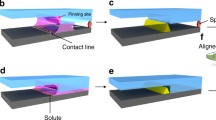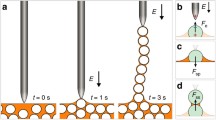Abstract
We report on the use of capillary interactions to drive the self-assembly of an electronic circuit based on mesoscale building blocks. The specific target structure is a linear heterotetramer comprising non-identical millimetre-scale cubic blocks that, following assembly, forms a functioning astable multivibrator circuit. Importantly, the self-assembly process is designed to be unconstrained, i.e., each of the blocks are free to move in any way during assembly. To this end, solder droplets are selectively patterned on the block faces. On contact, capillary interactions between shape complimentary solder patterns on the blocks cause the molten solder droplets to coalesce and the blocks to self-assemble. In this way, capillary forces direct the alignment, registration, linking and electrical interconnection of each block during the assembly process. This demonstration of mesoscale self-assembly mediated by capillary interactions illustrates that the application of unconventional assembly paradigms to complex structure fabrication is feasible and that these approaches may yet yield viable strategies for fabrication of highly integrated systems.
Similar content being viewed by others
References
N.B. Bowden, M. Weck, I.S. Choi, G.M. Whitesides, Acc. Chem. Res. 34, 231 (2001)
M. Madou, Fundamentals of Microfabrication (CRC Press, New York, 1997)
C.J. Morris, S.A. Stauth, P.A. Parviz, IEEE Trans. Adv. Packag. 28, 600 (2005)
H.-J.J. Yeh, J.S. Smith, IEEE Photon. Technol. Lett. 6, 706 (1994)
C.S. Lee, H. Lee, R.M. Westervelt, Appl. Phys. Lett. 79, 3308 (2001)
B.A. Grzybowski, A. Winkleman, J.A. Wiles, Y. Brumer, G.M. Whitesides, Nat. Mater. 2, 241 (2003)
A. O’Riordan, P. Delaney, G. Redmond, Nano Lett. 4, 761 (2004)
T.D. Clark, J. Tien, D.C. Duffy, K.E. Paul, G.M. Whitesides, J. Am. Chem. Soc. 123, 7677 (2001)
U. Srinivasan, D. Liepmann, R.T. Howe, J. Microelectromech. Syst. 10, 17 (2001)
J. Fang, K.F. Böhringer, J. Micromech. Microeng. 16, 721 (2006)
N. Bowden, A. Terfort, J. Carbeck, G.M. Whitesides, Science 276, 233 (1997)
A. Terfort, N. Bowden, G.M. Whitesides, Nature 386, 162 (1997)
H.O. Jacobs, A.R. Tao, A. Schwartz, D.H. Gracias, G.M. Whitesides, Science 296, 323 (2002)
S.A. Stauth, B.A. Parviz, PNAS 103, 13922 (2006)
W. Zheng, P. Buhlmann, H.O. Jacobs, PNAS 101, 12814 (2004)
W. Zheng, H.O. Jacobs, Adv. Funct. Mater. 15, 732 (2005)
D.H. Gracias, J. Tien, T.L. Breen, C. Hsu, G.M. Whitesides, Science 289, 1170 (2000)
A.H. Cannon, Y. Hua, C.L. Henderson, W.P. King, J. Micromech. Microeng. 15, 2172 (2005)
M. Boncheva, D.H. Gracias, H.O. Jacobs, G.M. Whitesides, PNAS 99, 4937 (2002)
Author information
Authors and Affiliations
Corresponding author
Electronic Supplementary Material
Below is the link to the electronic supplementary material video object. (707 KB)
Rights and permissions
About this article
Cite this article
Reynolds, K., O’Riordan, A. & Redmond, G. Self-assembly of a functional electronic circuit directed by capillary interactions. Appl. Phys. A 98, 203 (2010). https://doi.org/10.1007/s00339-009-5374-0
Received:
Accepted:
Published:
DOI: https://doi.org/10.1007/s00339-009-5374-0




